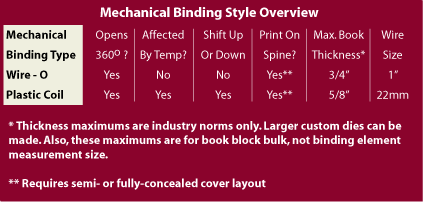| File Upload Home | Contact | Site Map |
|
|

 |
September 2008 - The Mechanics of Mechanical Binding Mechanical binding is an appropriate binding solution for many book projects. Imagine how poorly a perfect bound calendar would look dangling from a wall. For some calendar styles, saddle stitching is a reasonable alternative, but stitches just don’t have the same elegance as great looking mechanical binding elements. Properly executed mechanical binding is truly a marriage of form and function. While many books benefit from a layflat binding style, some books really must lie flat. Take cookbooks for example. Any cook with both hands busy, greasy or coated in flour knows that a perfect bound cookbook that snaps closed is hard to use. The alternative is breaking the spine, which causes pages to eventually fall out. Mechanical binding is a time-tested solution that solves this problem. Mechanical Binding Choices
Product Thickness For example, Wire-O comes in two pitch sizes: 3:1 (three holes per linear inch) and 2:1 (two holes per linear inch). Any book with a thickness of 1/2” or less requires 3:1 pitch wire, which means copy should be kept at least 3/8” away from the spine edge to avoid punching into type. Books bulking over 1/2” will use 2:1 pitch wire, which means your copy needs to be positioned at least 1/2” away from the spine. Punching into type for mechanical binding is a common problem, but unnecessarily so. When choosing the mechanical binding style that is right for your next project, involve the helpful binding experts at Feiereisen early. We can help your avoid layout errors and ensure you choose the mechanical binding style that best fits your project and your bottom line. The Feiereisen Advantage Feiereisen, Inc. is a leading provider of post press and finishing services including mechanical and adhesive binding, die cutting, embossing, foil stamping, pocket folders, tab dividers, UV coating, film lamination, scoring and perforation and more. Founded in 1933, Feiereisen has locations in Cedar Rapids, Iowa, Des Moines, Iowa and Kansas City, Kansas. |
 |
|
